3-Day Workout Template (Complete Guide and Workout Examples)
If you’re looking for an effective way to get into shape, without having to devote every day of the week to the gym, then a 3-day workout split could be just what you need.
Designed to give your body enough rest and recovery time, while still providing adequate workout frequency and total volume to allow you to make progress.
In this article, I will be giving you a free 3-day workout template to get you started, walking you through how to use the template, and discussing everything else you need to know about a 3-day workout split.
Jump to the sections below if you’re looking for something specific:
- Downloadable 3-Day Workout Templates (Free)
- What is a 3-Day Workout Split?
- Is the 3-Day Workout Routine Effective?
- How to Structure a 3-Day Workout Split?
- Which 3-Day Workout Split is Right for You?
- How to Create a 3-Day Workout Routine Using the Template
- 4 (Four) Examples of a 3-Day Workout Routine
- How To Progress Following a 3-Day Workout Split?
- Benefits of a 3-Day Workout Split
- Disadvantages of a 3-Day Workout Split
- Frequently Asked Questions
Downloadable 3-Day Workout Templates (Free)
Just want a free 3-day workout template?
Then here it is!
Click on the preferred format to download the template:
Simply click on the link, save the document to your device, or make a copy (in the case of Google Sheets or Google Docs), and you’re good to go.
If you would like to learn more about how to use the template and structure your workout, among many other aspects of a 3-day workout routine, keep reading!
What is a 3-Day Workout Split?
A 3-day workout split is a type of weight training program that involves structuring your workouts where you train 3 times a week.
The three workout days can be organized differently, with each workout focusing on different body areas and muscle groups. More on this in a bit.
You can use this type of program to gain muscle, focus on increasing strength, or lose fat. It’s versatile enough for various types of fitness goals and can be followed by beginners as well as intermediate to more advanced gym-goers.
The 3-day workout split provides your muscles with enough rest in between workouts to recover, while still having the frequency and volume needed to make progress.
Furthermore, with only 3 days of commitment per week, this type of workout program is ideal for those who have busy lifestyles.
Is the 3-Day Workout Routine Effective?
Yes, the 3-day workout routine can be an effective program for achieving your physique goals.
The trick with resistance training is to provide your muscles with an adequate stimulus for growth, which means having enough intensity (weight/resistance used) and volume (sets and reps).
The 3-day split allows you to do just that, while still allowing for enough rest and recovery time to make sure your muscles rebuild, repair themselves, and grow.
Of course, if you are very serious about bodybuilding, strength training, and so on, you may want to reconsider a 3-day split and opt for something more advanced – with much higher frequency. total volume, etc.
But for the majority of gym-goers, a 3-day split is more than enough to make great progress up until a certain point.
How to Structure a 3-Day Workout Split?
Here are some of the most common ways to structure a 3-day workout split:
Classic Bodybuilding 3-Day Workout Split
This is by far the most popular 3-day workout split.
On each workout day, you will be focusing on a different muscle group, for example:
- Day 1 – Chest, Shoulders, and Triceps
- Day 2 – Back and Biceps
- Day 3 – Legs and Core (Abs)
Between each workout, you could have one day of rest or an active recovery day.
Such a workout split allows you to hit all the muscles in your body, with adequate rest in between each session.
The total volume for certain muscle groups each day is fairly high since they are isolated on that particular day.
However, the frequency at which you get to work each muscle group is only once per week. Ideally, you want to hit each muscle group at least twice for the most optimal results.
Push/Pull/Legs Workout Split
This 3-day workout split is similar to the bodybuilding split above, but it divides your workouts into pushing and pulling movements.
On a “push” day, you would perform exercises that work primarily the chest, shoulders (especially front and side deltoids), and triceps.
On a “pull” day, you would focus on exercises that work your back, biceps, as well as the rare deltoid.
Finally, during a “leg” day, you would work all the muscles in your lower body such as the quads, hamstrings, glutes, and calves.
When it comes to training your core (abs), you could include core exercises on each of the 3 workout days. I would typically incorporate some sort of core exercise at the end of a leg workout.
To summarize the Push/Pull/Legs Workout Split could look like this:
- Day 1 – Push (Chest, Shoulders, and Triceps)
- Day 2 – Pull (Back and Biceps)
- Day 3 – Legs (Quads, Hamstrings, Glutes, Calves)
Similarly to the bodybuilding split above, you should add rest day(s) or an active recovery day in between each workout session.
Once again, the total volume is fairly high each day but the frequency with which you hit certain muscle groups is still only once per week.
But there are better ways to structure the 3-day split in order to get more out of it…
Upper/Lower Workout Split
The upper and lower body workout split puts a bit more emphasis on the frequency with which you train each muscle group by dividing your workout into an upper body day and a lower body day.
In other words, it divides all the target muscle groups in the body into 2 (two) categories, allowing you to hit them 1,5 times per week. Making it a more optimal workout split than the above two.
During an “upper body” workout day, you would work all your upper body muscles – chest, back, shoulders, biceps, and triceps.
On a “lower body” day, you would focus on all your lower body muscle groups – quads, hamstrings, glutes, and calves.
You would typically train your core (abs) on just one or several of the 3 workout days.
The important thing to note with the Upper/Lower Workout Split is that you would need to alternate your workout sessions in the following order:
- Week 1: Upper/Lower/Upper
- Week 2: Lower/Upper/Lower
- Week 3: Upper/Lower/Upper
- Week 4: Lower/Upper/Lower
- And so on…
TIP
To add more variety to your exercise selection, you can create 2 versions of each workout day (A and B) and switch between them every time you hit the gym.
Here is an example of how you could alternate these 2 versions:
- Week 1: Upper A/Lower A/Upper B
- Week 2: Lower B/Upper A/Lower A
- Week 3: Upper B/Lower B/Upper A
- Week 4: Lower A/Upper B/Lower B
- Week 5: Upper A/Lower A/Upper B
- And so on…
The same as with the previously mentioned splits, you should add rest day(s) or an active recovery day in between each workout session.
Overall, the upper/lower workout split is a great option for those wanting to hit each muscle group with higher frequency. Although it may decrease the total volume for each muscle group during a workout session.
As such, it is one of the most popular workout splits for those wanting to enjoy the best of both worlds – frequency, and volume, while still hitting the gym 3 days a week.
Full Body Workout Split
Finally, the full-body workout split involves training all the major muscle groups in the body on each of your 3 workout days.
It is arguably the best option for those wanting to hit each muscle group with high frequency while working out only 3 times a week.
When created properly, the full-body workout split can provide you with the highest frequency without completely exhausting your body.
A typical full-body workout would involve performing exercises that target the chest, back, shoulders, biceps, triceps, quads, hamstrings, glutes, and calves.
You would then add core exercises on each or some of the 3 workout days.
With the full-body workout split, it is a good idea to vary your exercise selection throughout the week by creating multiple versions of the full-body workout.
For example, on a week-by-week basis, you could alternate your workouts between the following:
- Week 1: Full Body A/Full Body B/Full Body A
- Week 2: Full Body B/Full Body A/Full Body B
- Week 3: Full Body A/Full Body B/Full Body A
- And so on…
Or you could even create 3 different versions of the full-body workouts and perform them back-to-back in a single week, like this:
- Week 1: Full Body A/Full Body B/Full Body C
- Week 2: Full Body A/Full Body B/Full Body C
- Etc.
Again, you would include a rest day or two, or an active recovery day in between each workout session.
All things considered, the full-body workout split can be ideal for those just starting out with a consistent workout routine since it provides the opportunity to train each muscle group with higher frequency without overloading your body.
Furthermore, it allows for learning the correct exercise form and technique faster.
For more advanced lifters, however, it might not be the best option due to its lower volume, which could potentially lead to slower results (depending on the goals).
Still, it is a great option for those who are looking to hit the gym 3 days a week and still get in enough work for each muscle group, at a high frequency.
Which 3-Day Workout Split is Right for You?
Now that you know the basics of each one of structuring the 3-day workout split, it is time to decide which one is right for you.
The best way to choose is by taking into account both your goals and your current level of fitness.
For Beginners
If you are a beginner, it is likely best to start with the full-body workout split since it allows you to learn proper exercise form and technique, while hitting each muscle group with high frequency.
Alternatively, you could also follow the upper/lower split. It is also a great way to get started and could be more easily adapted if you decide to transition into higher-volume training routines later on.
For Weight Loss
If you are looking to lose weight, the full-body, as well as the upper/lower workout split, can both be great options.
Both involve performing mostly compound exercises that involve multiple muscle groups, which can help you burn more calories.
However, do keep in mind that diet is more important when it comes to weight loss than the type of workout split you use.
So, make sure that you are also creating a nutrition plan that helps you create the calorie deficit needed to lose weight. Feel free to check out an article on how to create and follow a cutting diet to learn more.
For Building Muscle
For those looking to build muscle, the best option would be either the upper/lower, push/pull, or even the body part (classic bodybuilding) splits.
These allow for higher volume and more time under tension, which are both important factors for building muscle size. Those splits also allow you to focus on one muscle group at a time, which can help ensure that each muscle is being stimulated optimally.
Remember, though, that total volume and progression are key when it comes to building muscle. Make sure to focus on gradually increasing the weight or reps you perform each workout session.
In regard to the diet, a caloric surplus and sufficient protein intake are highly important for muscle growth. You can check out the lean bulking diet guide to learn more about how to construct a muscle-building diet.
For Increasing Strength
Finally, for increasing strength, the upper/lower and the full-body split can be great options.
Both allow you to focus on the main compound lifts (squat, bench press, deadlift) while still hitting each muscle group with high frequency.
The key here is to focus on gradually increasing the weight you use each workout session.
This will allow you to get stronger over time and eventually hit bigger numbers on the main lifts.
Again, having a good diet plan is just as important as having a good workout routine. The most important factor when it comes to increasing strength is making sure you are getting enough protein and calories (preferably from nutrient-dense sources) while staying in a slight caloric.
How to Create a 3-Day Workout Routine Using the Template
To create a 3-day workout routine using the template we have just discussed, you will need to:
- Decide how you would like to structure your 3-day workout split
- Choose the exercises you would like to do for each muscle group
- Decide how many sets and reps you would like to perform for each exercise
- Decide on the rest period for each set
- Organize the exercises into 3 separate workouts
- Pre-fill the weight you will use for each exercise (optional)
Let’s briefly run through all these steps in more detail so you can get started on creating your own 3-day workout routine.
I will be using the 3-day workout template in Google Sheets file format as an example.
It is the most advanced version of the template and has features that you can utilize to help you create your own workout more easily, such as dropdown menus for the exercises, a large exercise library, and more.
You can get the template in a file format of your choice – here:
If you want to create a workout routine for more than 3 days, you can use any of the Google Sheets workout templates, and simply delete any days that you don’t need.
For even more options, check out the full workout template library to find a template that suits you best.
1. Decide how you would like to structure your 3-day workout split
First, you will need to decide how you would like to structure your 3-day workout split.
We have already gone through the different splits you can choose, so pick the one that best suits your goals and preferences.
You can then name the template to reflect the type of workout split you chose to follow.
As well as other details like the duration of the program and so on.
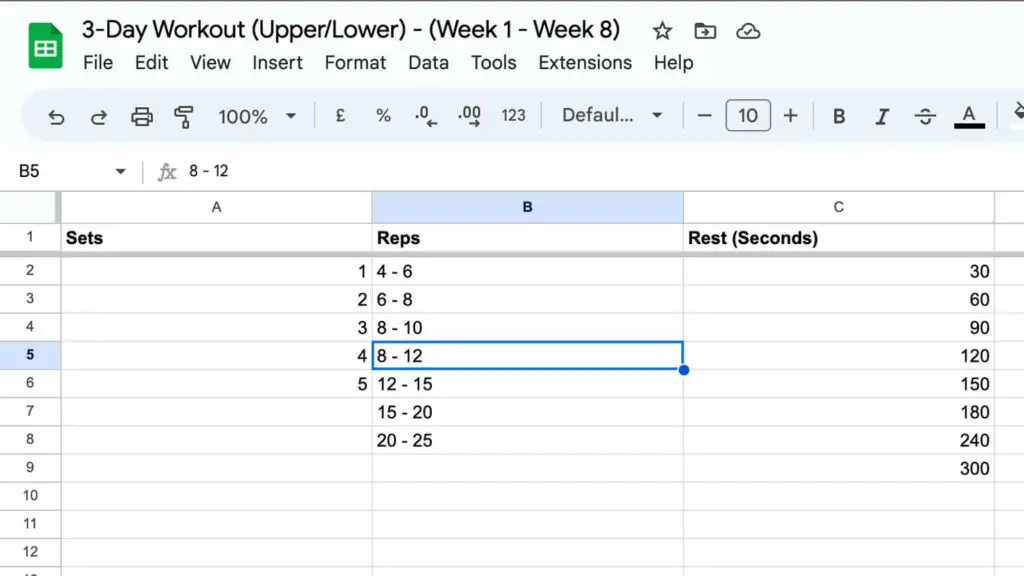
You can then go to the “Workout Setup” tab and change the name of each day of the workout to better reflect the type of workout you are doing that day.

2. Choose the exercises you would like to do for each muscle group
Once you have decided on the split, it is time to pick the exercises you will be doing for each muscle group.
In the “Workout Setup” tab of the template and start filling it out by first selecting the muscle group you would like to work on when performing any given exercise.
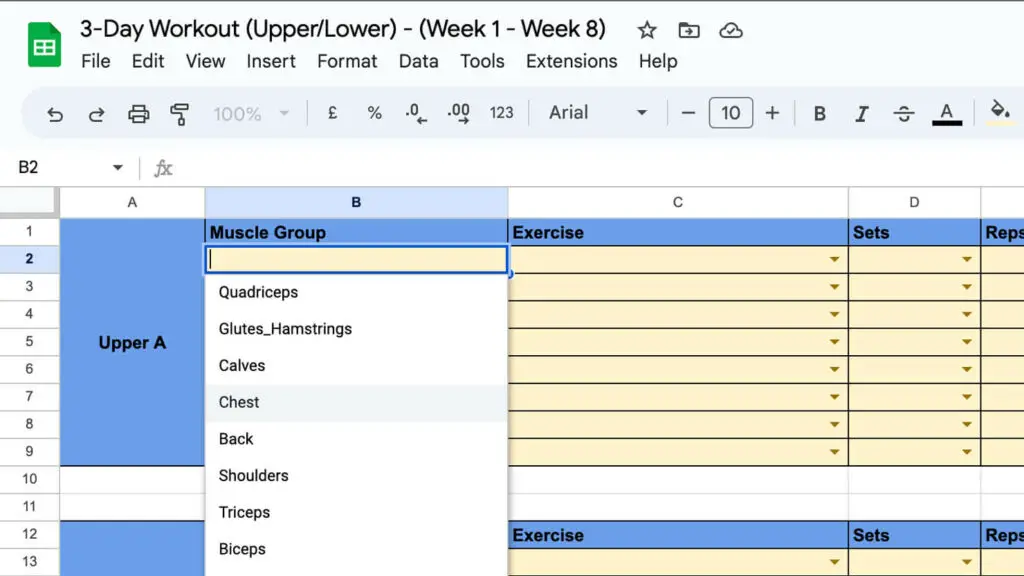
NOTE
Each row represents all the data associated with a single exercise.
Then, select the type of exercise you want to perform.
Using the Google Sheets workout template, you can choose from a range of exercises, such as compound, isolation, and accessory lifts.
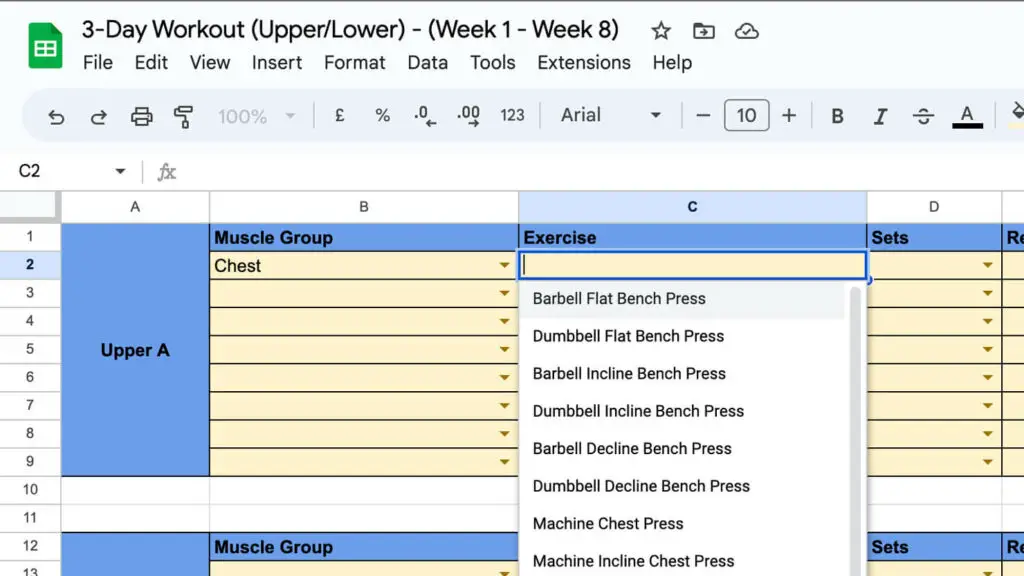
The template also allows you to add your own exercises if you don’t see the one you want.
Here’s how:
- Go to the “DATA” tab.
- Find the column with a header name representing a muscle group for which you would like to add an exercise.
- At the bottom of the existing list, type in the name of the exercise that you would like to add.
Once it is added, the exercise will be available in the dropdown menu for that muscle group when you go back to the “Workout Setup” tab.
3. Decide how many sets and reps you would like to perform for each exercise
Then, you need to determine the number of sets and reps you will do for each exercise.
In the “Workout Setup” tab of the template, you will find a column labeled “Sets” where you can select the number of sets that you want to do for each exercise.

You can also select the rep range in the “Reps” column to specify how many reps you would like to perform for each set.

4. Decide on the rest period for each set
Next, you will need to decide the rest period between each set of exercises.
This is important to ensure that you can perform the next set with enough energy and intensity.
You can specify this information in the “Rest (Seconds)” column.
Simply select the number of seconds that you would like to rest between each set.
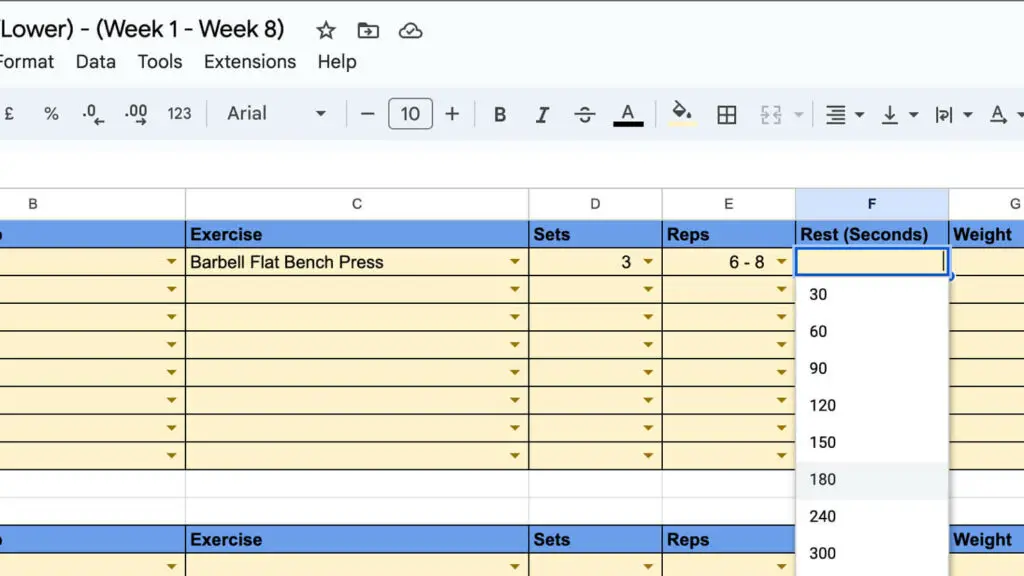
5. Organize the exercises into 3 separate workouts
Continue filling in the rest of the rows until you have filled out all the exercises for each muscle group that you want to work on, on each workout day.
Organize the exercises into 3 separate workouts, depending on the split you have chosen.
Pay attention to things like the order of exercises and make sure that the total volume for each muscle group throughout the week is optimal and in line with your goals.
6. Pre-fill the weight you will use for each exercise (optional)
You can also pre-fill the weight that you will use for each exercise.
This is an optional step but it can save you time when you’re actually in the gym if you already have a general idea of how much you will be lifting.
Just fill in the “Weight” column with the weight that you plan to use for each exercise.
Another optional column you can use is the “Notes” column, which lets you add any additional information that might be relevant to your workout routine, specifically that exercise.
For example, it could be a note regarding how to perform the exercise, a reminder of what to focus on, a note about how the exercise felt, and/or whether the weight should be increased next time.
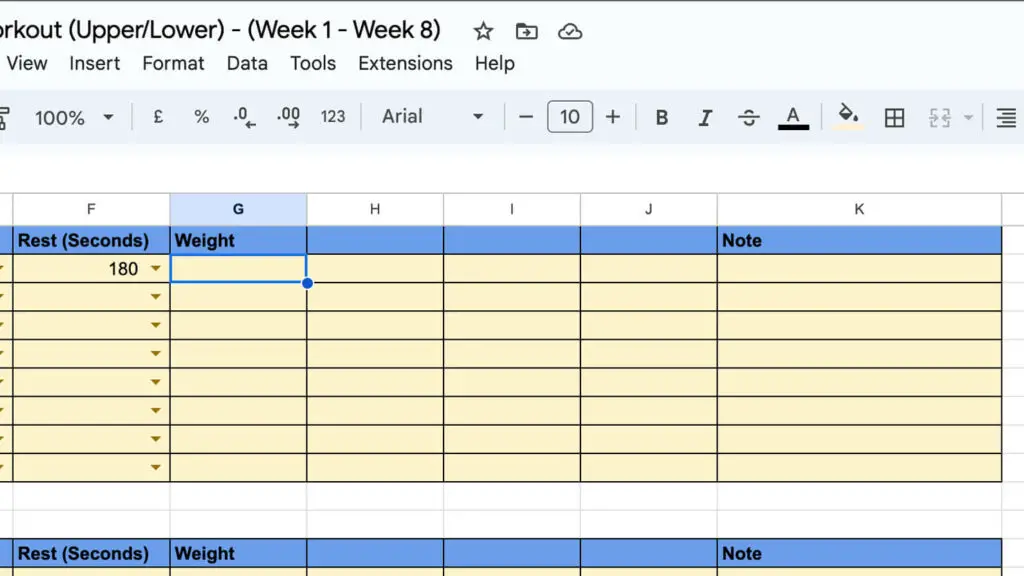
And that’s it! You now have a 3-day workout routine with all the necessary information filled out in the Google Sheets template.
You can learn more about how to create workouts in Google Sheets in the full guide, including how to use it to track your progress.
Or check out the video below if you prefer to learn visually.
4 (Four) Examples of a 3-Day Workout Routine
Using the same template, I have created 4 (four) simple 3-day workout routine examples, which you can further customize to suit your needs.
One for each of the four ways to structure a 3-day split.
Classic Bodybuilding Workout Split Example
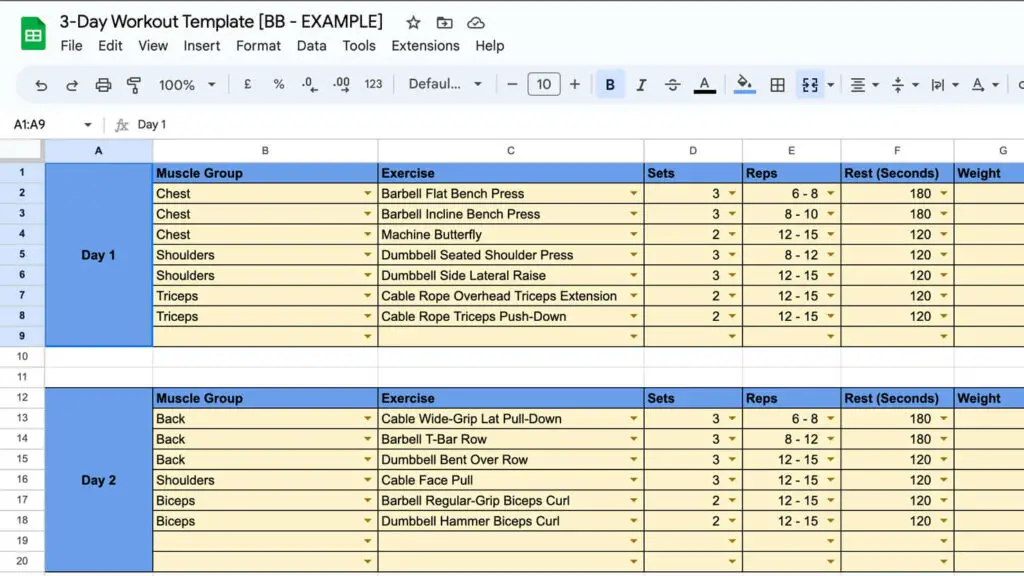
The idea of this workout routine is to target larger muscle groups with compound exercises, and then do a few isolation exercises for smaller muscles.
You can make a copy of the workout template to use this example as a starting point for your own 3-day workout routine. Just pick the file format that works best for you to download it to your device or make a copy of it on your Google Drive:
Push/Pull/Legs Workout Split Example

As mentioned earlier, this type of split focuses on pushing and pulling exercises to target upper-body muscle groups. And leg exercises to target the lower body.
Feel free to get a copy of this workout example by accessing it in the file format you prefer:
To create your own Push/Pull/Legs workout, feel free to use the free Push/Pull/Legs workout template to get started fast.
Upper/Lower Workout Split Example

Links to download this example of a workout split in the file format of your preference:
NOTE
The PDF version of this workout split example comes in two files: Week 1 Workouts, and Week 2 Workouts. That is because this is an upper/lower split with alternating workouts (Upper A; Lower A; Upper B; Lower B), one file contains all the workouts (Upper A; Lower A; Upper B) for Week 1 and the other contains all the workouts for Week 2 (Lower B; Upper A; Lower A).
Full Body Workout Split Example
And finally, here is an example of a full-body workout split.

To make a copy of this workout for your own use, here are the links to download it in the file format you prefer:
How To Progress Following a 3-Day Workout Split?
When it comes to progressing with your 3-day workout split, the same fundamentals regarding progression apply. These are the main techniques:
1. Increase the weight you use for each exercise. Every time you hit the top repetitions of a pre-determined rep range for two consecutive workouts – simply add a couple of kilos or pounds to the weight you use for each exercise. For example, if you’re doing 3 sets of 8-10 reps and you hit 10+ reps on two consecutive workouts, increase the weight slightly.
2. Increase the number of repetitions (reps) you perform for each set. Instead of increasing the weight, you can also try to increase the number of reps you do for each set. For example, if you’re using a particular weight and doing 3 sets of 8-10 reps pretty comfortably, then you can increase the rep range to 10-12. Thereafter, aim to hit the top of the rep range for two consecutive workouts before increasing the weight.
3. Increase the total number of sets you perform for each muscle group. Another option you have is to increase the total number of sets you do for each muscle group. For example, if you’re doing 3 sets for a particular muscle group, you can increase it to 4 or 5 sets. This will help you increase the volume of work done (sets x reps) and as a result, help make progress in regard to strength and muscle hypertrophy over time. But make sure you pay attention to how your body is responding to the extra volume, as it also may need extra time to rest and recover.
4. Pick more challenging exercises. You can also make progress by picking harder variations of the same exercise. For example, if you’re doing a chest press using the machine, you can switch to an incline barbell chest press. Likewise, if you’re doing a regular leg press using the machine, you can switch to a single-leg press, regular squats, or Bulgarian split squats, all of which are more challenging variations.
5. Decrease rest periods. You can also make your workouts more challenging by decreasing the rest period between sets. For example, if you’re resting 60-90 seconds in between each set, try decreasing it to 45-60 seconds. This will definitely add more intensity to your workouts.
6. Slow down your reps. You can also add more time under tension by slowing down the tempo of your reps. For example, when doing a given exercise you can slow down the eccentric (lowering) phase and hold each rep for a couple of seconds before doing the concentric (lifting) phase. In fact, this could be the first technique I would recommend to someone looking to progress before trying out any of the other techniques mentioned here, as it will also help ensure you learn a proper exercise form.
7. Increase the difficulty of your workouts. Lastly, you can also try to make your workouts more challenging by adding drop sets, supersets, and tri-sets. Drop sets involve doing a set of an exercise at a specific weight, then immediately reducing the weight and doing another set with the reduced weight. Supersets involve doing two exercises back-to-back with no rest in between them (targeting opposing or non-opposing muscle groups). Lastly, tri-sets involve doing three exercises back-to-back with no rest in between them. Although these techniques are tailored for more advanced lifters, you can still give them a try to make your workouts more challenging.
Benefits of a 3-Day Workout Split
There are several benefits to following a 3-day workout split, such as:
- You can target each muscle group with more intensity
- You can focus on compound exercises
- You have more time to recover between workouts
- You don’t have to spend as much time in the gym
- A great starting point for beginners
Disadvantages of a 3-Day Workout Split
Despite all the benefits of a 3-day split, there are also some drawbacks to consider:
- You may not be able to hit all the muscle groups with enough frequency
- You may have difficulty in progressing as a more advanced lifter
- It may be difficult to create a routine that targets all the muscle groups with enough volume
- Each workout session may take longer than a workout split with more days
Frequently Asked Questions
Is 3-Day Workout Good Enough to Build Muscle?
Yes, a 3-day workout split can be effective for building muscle if you are a beginner or intermediate lifter. However, if you are an advanced lifter, you may need to consider switching to a different split such as a 4-day or 5-day split to target each muscle group with more training volume.
Can You Get Ripped Working Out Just 3 Days a Week?
Yes, it is possible to get ripped working out just 3 days a week. Although the main progress driver to getting ripped will be your nutrition and following a diet that puts you in a calorie deficit.
A proper workout program on the other hand can help you maintain lean muscle mass (and perhaps even build some) while in a calorie deficit.
Can You Bulk on a 3-Day Split?
You can bulk on a 3-day split if you are a beginner or intermediate lifter. However, as an advanced lifter, it may be difficult to put on significant muscle mass by following a 3-day split as you would need more volume in order to stimulate muscle growth.
Furthermore, for having a successful bulk following a diet plan that puts you in a slight calorie surplus is essential.
Is It Better to Workout 3 or 4 Days a Week?
If you are a beginner or intermediate lifter, then a 3-day workout plan may be better as it would provide a good balance between frequency, intensity, and volume.
However, if you are an advanced lifter you may want to go with a 4-day split. It would allow you to target each muscle group with more volume and therefore, increase the potential for muscle gain.
Ultimately, it all comes down to your goals, experience level, as well as available time.
What Exercises Should I Do In a 3-Day Workout Split?
In a 3-day workout split, your focus should be on compound exercises such as squats, deadlifts, bench presses, shoulder presses, and rows. These exercises will allow you to target the major muscle groups and get the most out of your workout in a shorter period of time.
Additionally, you can also do some isolation exercises such as bicep curls, tricep extensions, and calf raises to help round out your routine. If you should put a ratio on the exercises, it should be around 80% compound and 20% isolation-type exercises.
How Long Should I Rest Between Sets In a 3-Day Workout Split?
The amount of rest between sets will vary depending on the type of exercise and your goals. For bodybuilding-type workouts, you could rest between 1-2 minutes.
For strength-focused workouts, rest periods should be longer with 3-5 minutes between sets.
An average rest time between sets for most lifters would be around 2-3 minutes.
Can I Do Cardio On Off-Days During a 3-Day Workout Split?
Yes, you can do cardio on your off days. This is a great way to increase your overall fitness and conditioning levels. However, it is important to keep in mind that too much cardio can lead to additional muscle fatigue.
So, you will have to structure your weekly workout schedule in a way that does not interfere with your primary workouts. For example, you could try to avoid doing cardio like running (or other leg-intensive activities) right after or before a workout day that also involves the lower body.
Can Beginners Do a 3-Day Workout Split?
Yes, beginners can do a 3-day workout split. This is a great way for beginners to get into weight lifting as it will allow them to focus on the major muscle groups, and learn proper form and technique.
Additionally, it is important that beginners focus on the basics and do not try to overcomplicate their routines. Thus, an upper/lower or a full-body split could be a great place to start.
How Long Should Each Workout Last In a 3-Day Workout Split?
A typical workout in a 3-day split should last no more than 60 minutes to 90 minutes. This would include the time to warm up, do your exercises, and cool down.
Assuming that an average rest time between sets is around 2-3 minutes, you should be able to do up to 5-7 exercises, with 3-4 sets per exercise, in that time frame.
When Should I Change My 3-Day Workout Split?
You could change your routine every 4-6 weeks in order to prevent plateaus, and keep progressing, while still enjoying the workouts and avoiding boredom following the exact same routine.
Hence some of the templates provided don’t allow tracking workouts for longer than 8 weeks. But you can easily reuse the template to create a new routine and start a new training cycle.
This could include switching exercises, changing the number of sets you do or the rep ranges, and changing the order of the exercises. Or even implementing some of the more advanced training techniques such as super sets, drop sets, tri-sets, or pyramids.
What Diet Should I Follow During a 3-Day Workout Split For Best Results?
Your diet should be tailored to your goals. If you are looking to build muscle then you will need to eat a calorie surplus that is composed of protein, carbohydrates, and healthy fats.
If you are looking to lose fat and tone up then you will need to focus on eating a calorie deficit and include plenty of lean proteins, complex carbohydrates, and healthy fats.
Finally, make sure to stay properly hydrated throughout the day as this will help you to maximize your results.
![How To Make a Workout Plan in Excel [With Template]](https://gfitnessonline.com/wp-content/uploads/2022/12/make-workout-plan-excel-768x384.jpg)
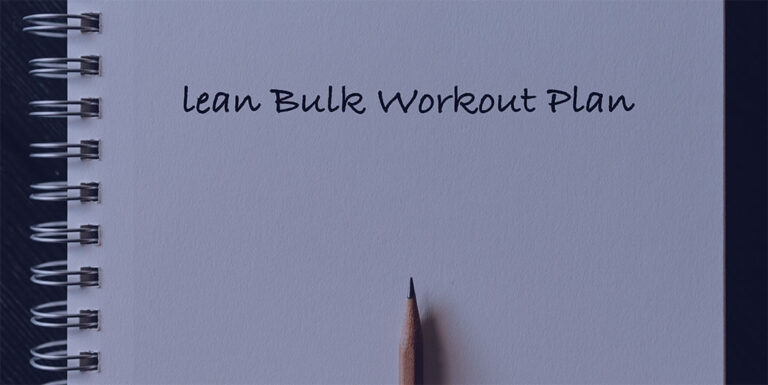

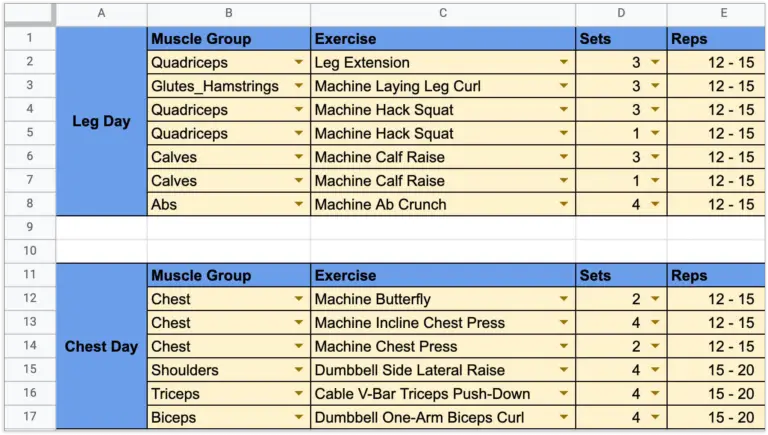
![How To Make a Workout Plan in Google Sheets [With Template]](https://gfitnessonline.com/wp-content/uploads/2022/12/create-workout-plan-in-google-sheets-768x384.jpg)
